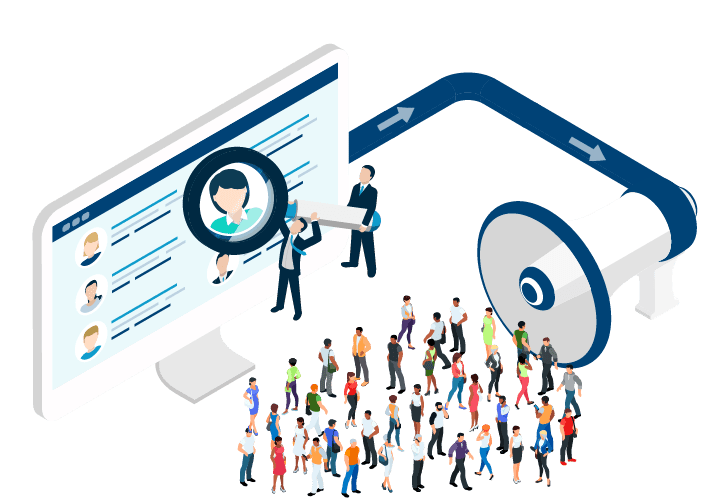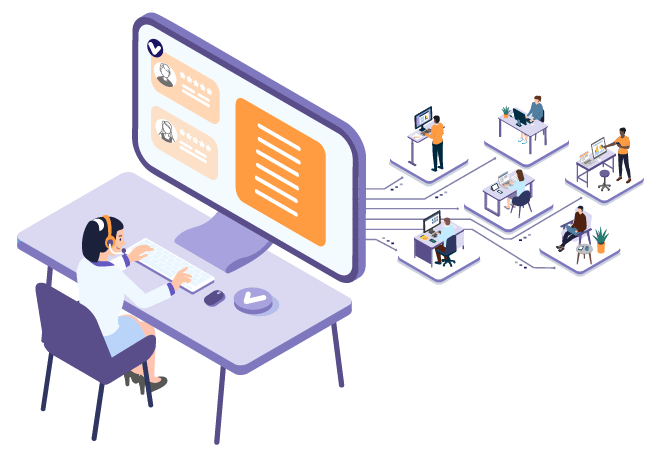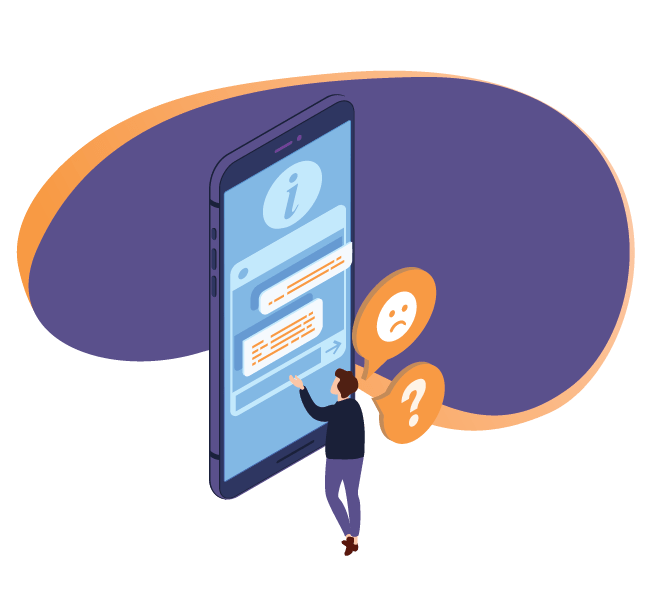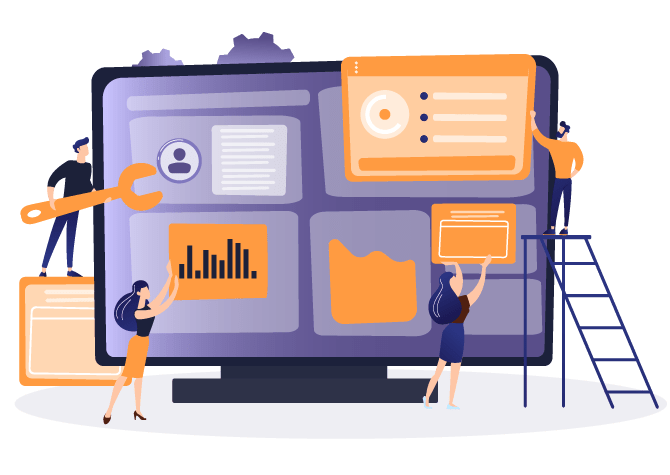
What Are the Customer Information Management Features of CRM?
CRM software should collect customer data from all available systems, deduplicate it with simple customer-based algorithms, and make it accessible for company users in different functions. Smart algorithms enable the consolidation of different information from different sources and communication channels, helping create a more refined customer database and preventing redundant data due to incorrect duplication.
Company-based customer cards (B2B) and person-based customer cards (B2C) should be usable individually or collectively. If there are changes to a customer’s profile information, the user should be able to easily add new data fields to the customer card without requiring any technical support. Users should also have the means to create tags specific to sales channels that define the unique characteristics of each customer and assign these tags individually or collectively. This facilitates the creation of an unlimited number of micro-segments and the defining of customized datasets, which are required for hyper-personalization. Users should be able to access all kinds of customer data depending on their level of authorization and utilize it in their jobs.
To help you embrace a holistic approach to customer relations, customer cards should allow you to:
- track sales progress;
- monitor interactions across all channels and manage customer communications;
- follow up on customer-related tasks assigned to users;
- view documents shared with customers;
- take notes about customers;
- examine customer survey results; and
- fully monitor customers’ digital behaviors.
Users should also be able to define custom datasets for customer cards and add inventory-type data such as orders, invoices, transactions, issues, and service requests. All data added should be automatically usable in analyses and reports without any further effort.
What Are CRM’s Marketing Management Features?

Marketing professionals often have their own unique methods when it comes to getting things done. Marketing is the primary business function that promotes and represents the company in the market; the marketing capabilities of CRM should therefore facilitate this front-line responsibility. A CRM system should offer the ability to manage customer communication and facilitate all marketing campaigns aimed at increasing leads, strengthening brand recognition, improving sales opportunities, and boosting customer loyalty. CRM’s most basic marketing features include creating marketing campaigns and automating them across channels, tracking read/unread email statuses, acquiring statistics on clickthrough rates, and creating A/B tests to determine how customers access webpages.
A marketing CRM should be able to report on when leads visit your website, the links they click, and the type of personal information they share on a form. Being able to perform dynamic marketing segmentation facilitates the creation of customized campaigns that will make you the top-of-mind brand for potential customers.
Users should also be able to determine custom target audiences for campaigns on a single platform, design special content for these audiences across all communication channels, and report the results by implementing the campaigns through the defined channels without requiring different solutions and software.
The system should have an automation feature that can take action automatically when a certain event is triggered depending on a business rule. For instance, the following steps should be automated:
- Assigning a “call” task to your salesperson when a customer opens a quote email
- Displaying a renewal pop-up when the customer visits the webpage 10 days before the contract renewal period
- Sending personalized congratulatory messages for recurring events, such as birthdays or membership anniversaries
- Sending special text messages to customers who, for example: click on the promotion page of a new product, have more than 10 years of experience in the finance industry, have placed at least two orders from your e-commerce site in the last three months, have a customer lifetime value of over 1450, and have an NPS score of 8+
- Sending an automatic online meeting invitation when your customer fills in the membership form on your webpage
- Sending each customer a message inviting them to the nearest store when they click on the promotion page for a new product
- Creating a special landing page for customers in the contract phase
- Triggering an SMS or push notification to the customer when an email sent to the customer cannot be delivered
- Displaying a special message/suggestion when a custom value in a specific customer data field changes
What Are CRM’s Sales Management Features?
CRM programs are designed to sell a product or service. However, some CRM solutions focus specifically on sales. These sales-oriented CRMs have very powerful tools for shortening sales processes and increasing closing rates and sales efficiency.
A sales-oriented CRM program offers the ability to manage leads, sales processes, and sales teams. It allows you to build a sales pipeline, track leads, and significantly increase your awareness of sales opportunities. Sales workflows can be streamlined and any customer interaction can be managed on a single platform.
Of course, having an “all-in-one” CRM for sales, marketing, and customer service and being able to manage everything effectively in one place is the best possible solution. This includes managing leads, contacts, and opportunities, as well as customer profiles, quotes, and marketing communication campaigns. CRM’s sales management features identify where a customer is in the sales cycle and allow you to motivate them to the next sales step with personalized information. Additionally, opportunity management features help you track sales step-by-step to ensure that you make the right suggestion to the right customer at the right time.

Account management is another key feature of sales management. This includes the digital behaviors of customers; documents such as presentations, catalogs, quotes, and contracts shared with the customer; payment collection status; and special tags that help distinguish individual customers, which can be managed on customer account cards.
Intermediary performance monitoring tools are also very useful for evaluating and encouraging your team, making arrangements for teammates, and scheduling slow and busy periods.
Users should be able to define a large number of individual and corporate sales processes and to easily manage sales steps by connecting them to sales activities and monitoring the relevant sales channel and agent. Moreover, in sales and opportunity management processes, it should be simple to add data fields specific to each opportunity at any time and to track all necessary sales information from a single point. Each salesperson should be able to monitor their assigned opportunities step by step on a single dashboard, and the sales manager should be able to smoothly follow the opportunities of all salespeople in a single interface.
The lead conversion probability of each sales process step should be automatically calculated and reported according to different pricing models. This will allow for more realistic sales turnover estimations.
What Are CRM’s After-Sales Customer Service Management Features?
CRM integrates and categorizes customer issues from all communication channels with customer service management features, provides end-to-end solutions with defined processes depending on service level objectives, and automatically informs all parties involved in the solution process step by step. It also notifies sales and marketing functions of any reported or resolved issues.
ATTRACTING A NEW CUSTOMER IS 6–7 TIMES MORE EXPENSIVE THAN RETAINING ONE.
Marketplace competition is fierce, and customer service is now more important than ever. Against the backdrop of a radical paradigm shift in business management, CRM software features now offer the opportunity to manage sales, marketing, and customer service in one solution. The intertwined and customer-centric management of these three main business functions, facilitated by advanced CRM software features, helps build a customer-oriented corporate culture and allows businesses to seamlessly monitor the entire customer experience journey. This integrated structure, enriched by the capabilities of CRM software features, provides a unified customer database and increases team collaboration and issue resolution efficiency, ultimately improving customer satisfaction and loyalty. Ease of access to all customer data, thanks to the comprehensive CRM software features, offers permanent ways to create faster and smarter solutions for customer demands.

The most critical function of a customer-service-oriented CRM is to provide customers with a true omnichannel experience. This requires more than listening to customers from multiple communication channels (e.g., email, chat, social media, call center, complaint sites, etc.); all issues from these channels should be integrated on a per-customer basis and managed simultaneously as if via a single channel. In other words, if a customer calls the call center immediately following a chat with an employee in a different department, the customer service agent greeting the customer must be aware of that conversation and conduct the call accordingly.
An ideal CRM system grants all personnel instant access to information concerning the customer’s company/brand interaction history from all communication channels. This leads to faster solutions and increased customer satisfaction, directly lowers customer churn, and increases reacquisition rates as well as profitability.
“A 5% INCREASE IN CUSTOMER LOYALTY INCREASES COMPANY REVENUE FROM 25% TO 85%.” – Frederick F. Reichheld (The Loyalty Effect)
It is critical for a customer-service-oriented CRM to have a categorical infrastructure. Each customer issue should be categorized by subject, recorded in the CRM, and resolved based on the corporate resolution processes and service level agreement (SLA) created specifically for these categories. Due to the natural increase in the number of customer issues in all industries and the unique difficulties and constraints of customer service offered at level 1, there is a significant risk of customer issues being miscategorized. Fortunately, CRM software can eliminate this risk using artificial intelligence. In fact, for categories with established solutions, the artificial intelligence module should automatically categorize issues without requiring human support. The module can fetch the solution, forward it to the customer, and resolve the issue, and then create, categorize, and analyze a record of the customer issue – all without human touch.
Another key CRM feature used for customer service is the ability to manage customer issues with defined processes based on category. These processes should facilitate the definition of workflows for each type of issue, and the issue should be managed automatically in line with these steps. In doing so:
1.The issue resolution process is automated using workflows
2.Issues are transformed into small, meaningful tasks by defining each step for each individual
3.The resolution process is monitored systematically depending on the service level objectives
4.In case of delays, the responsibility for resolving an issue is assigned to a senior manager based on the escalation chain
5.Performance becomes measurable and reportable
6.Issue details enable the transparent monitoring of durations, tasks, and those responsible
7.Business rules specific to workflows can be defined, as can subsequent conditional workflows

A customer relationship management system should make life easier for users, especially for customer service purposes. For instance, call center agents should be able to benefit from the Knowledge Base, which they can utilize to easily find answers to customer questions concerning the company’s products and services.
Another version of this reference point, which can be enriched with each resolved issue, should be offered to customers through the self-service portal that they can access from the company’s website. Before logging an issue with the self-service portal or calling the call center, customers should be able to search for answers to their questions in the Knowledge Base on the company’s website, without having to log an issue with text or images in the Q&A form.
The self-service portal is one of today’s most popular service points in the field of customer service management. From this portal, customers may log issues, just like a CRM user would, by filling in data fields that can be customized based on categories. This portal also enables customers to track issue progress, ensuring they do not have to rely on the call center to monitor their issues.
While all of these features are incredibly important to the business, if you were to ask us what the lifeblood of a CRM program is, we would say the automatic notification feature with customizable template messages. This feature helps customers and users track the status and progress of issues.
Another must-have customer relationship management software feature that stands out in customer service management is agent scripting, which is used primarily to manage the customer interactions of call center personnel. This feature enables the preparation of separate scripts on the user page for each category, which are explained step by step for the agent’s convenience. The explanation that the agent should give to the customer or the questions to be asked change on the screen in real time as the customer answers the agent’s questions.
What Are CRM’s Task Management Features?
With a CRM system, all tasks related to sales, marketing, and customer service are managed on a single platform with strong coordination and collaboration. The tasks in various task groups can be assigned to users, monitored, tagged, and reported. Notes, documents, or comments regarding these tasks are added to task details. The assigned user and followers are notified of changes made to tasks via an automated email.
Thanks to CRM software, companies can manage all customer-related work on a digital dashboard within task disciplines while also measuring, monitoring, and reporting on performance.
What Are CRM’s Reporting and Analysis Features?
The end-to-end management of all customer-related work on a single customer relationship management platform enables monitoring, reporting, and analyzing of performance outputs. The reporting and dashboard layer of CRM makes ready-to-use dashboards available to the sales, marketing, and customer service teams so that they can track industry-standard key performance indicators (KPIs) through charts or graphics. Basic operational reports facilitate more in-depth analyses. With customizable reports, organizations may perform ad-hoc analyses or evaluations according to their needs.
The most distinctive CRM reporting feature is that, when added to any module of the CRM, new data fields can be used in the reporting layer and included in the reports without requiring a custom definition or technical support. To ensure the easy analysis of reports, the ability to drill down into the details is another essential factor to consider. Additionally, these reports can be exported when necessary and can be easily integrated with whatever reporting application the organization is currently using.
What Are CRM’s Design and Adaptation Features?
Sales, marketing, and customer service represent the most dynamic and vital functions of a business because they are in direct contact with customers and represent the organization/brand on the market. Thus, truly agile business management requires that the customer relationship management system on which these vital functions are managed can be easily updated at any time according to the constantly evolving customer expectations and market trends. Users should not have to waste time and allocate an additional budget to ensure compatibility between the CRM software and the organization’s existing infrastructure, or be constantly adapting and updating it.

Employees who receive key user training for customer relationship management software should easily be able to make any desired adaptation themselves without requiring technical support, code knowledge, or consultancy from the CRM provider. A CRM software with a no-code design can achieve this. This way, the existing IT resources of the organization can focus on their main tasks, and there is no need to spend additional time or resources on CRM management. The savings in this area alone prove that CRM is one of today’s wisest business investments.
The competitive advantages afforded by this no-code technology should also be emphasized. To keep up with today’s dizzying pace of change, organizations must either endure very high costs or stay one step ahead by utilizing smart customer relationship management solutions with a no-code, cloud-based infrastructure. The inherent flexibility and adaptability of CRM features and benefits play a crucial role in empowering organizations to swiftly customize and optimize their customer management processes, ensuring a cost-effective and agile approach to meet the challenges of the modern business landscape.
What Are CRM’s Compliance Features?
Customer rights and customer information security are secured by international standards. The GDPR (General Data Protection Regulation) in all European Union countries and the LPPD (Law on the Protection of Personal Data) in Turkey give organizations and individuals responsibilities in many areas to maintain the protection and security of customers’ personal data. A customer relationship management program must comply with the security standards stipulated by the laws.
Next4biz CRM is completely aligned with GDPR, CCPA and LPPD regulations. Through data centers in the EU, US and Turkey, personal data is stored and processed in the privacy region of your country.
In addition to the legal obligations, a CRM program must also comply with international standards for personal data security in accordance with the BS 10012 Personal Information Management System and ISO 27701 Privacy Information Management System. For a cloud-based CRM program, the ISO 27001 Privacy Information Management System and the operation of the data center according to international standards should be key considerations.
Additionally, customer relationship management solutions, especially those used in customer service management, should fully comply with the ISO 10002 Customer Satisfaction Quality Standards, which is the most important international standard in this field.
What Are CRM’s Integration Features?
The more advanced the integration capability of a CRM system is, the more comfortably the organization can manage all the work on a single screen. Integration flexibility is a must-have feature of CRM software. Integrating with applications such as the ones listed below makes it easy to manage the entire interaction network with the customer and perform all tasks on a single screen through bilateral integrations with all the other corporate systems.
Communication Channels Integration:
- Call center applications (Alotech, 3CX, Avaya, Interactive Intelligence, Genesys, etc.)
- Email services
- Social media management applications
- Complaint sites
- Application platforms (App Store, Play Store, etc.)
- Instant messaging applications (WhatsApp, etc.)
- Live chat/chat bot applications
- Webpages
…
Business Systems Integration: - ERP: Enterprise resource planning applications
- CRM: Customer relationship management applications
- LDAP: Authentication applications
- SSO: Single sign-on applications
- HRM: Human resource management applications
- BPM: Business process management
- BI: Business intelligence and reporting applications
- MES: Manufacturing execution system
- PLM: Product lifecycle management practices
- RPA: Robotic process automation applications
- SCM: Supply chain management applications
- EAM: Enterprise asset management applications

